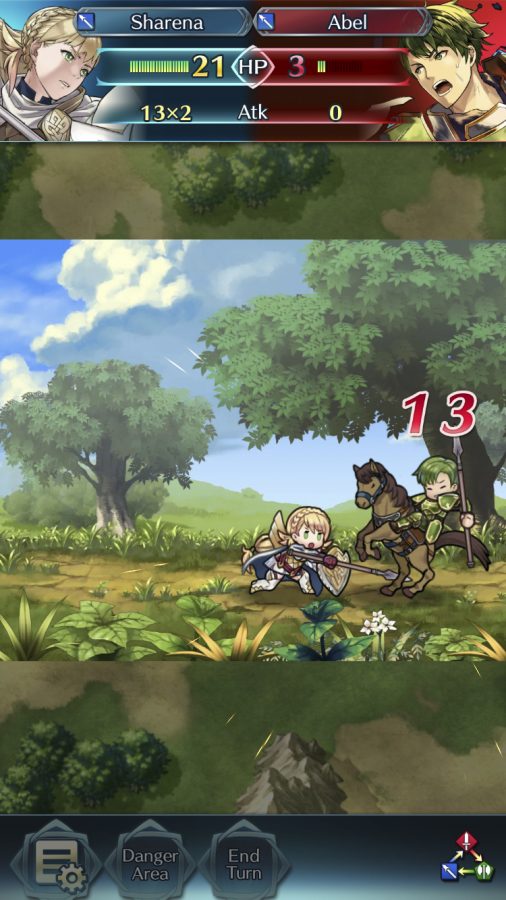Heroes Brings Pared Down Version of Classic Nintendo Title
Photo courtesy of Daniel Markus, Arts editor
Two heroes battle in Nintendo’s latest mobile game Fire Emblem Heroes, a stripped down and free-to-play adaptation of the Fire Emblem series developed by Intelligent Systems and released Feb. 2.
March 31, 2017
Nintendo released Fire Emblem Heroes, its second game for mobile devices after December’s lackluster Super Mario Run, on Feb. 2. The game is part of a series of five mobile apps created in a partnership with Japanese e-commerce company DeNA intended to help grow Nintendo’s core fan base, which has aged and waned in recent years. Much like Super Mario Run, Heroes is a simplified version of a major franchise, the Fire Emblem series, which has gained massive popularity in recent years after releases for Wii and 3DS.
As a series that has previously prided itself on massive fights, short but well-written character interaction, strategy and intricate battle mechanics, there was some question as to how the games would translate to a mobile device. Every previous iteration of the series in recent years has operated on a more robust gaming platform, whether a home console or a device in Nintendo’s Gameboy DS line. With this in mind, Intelligent Systems, the developer behind Heroes, successfully designed a game for simpler systems like iOS and Android devices.
Players control teams of four heroes in a number of turn-based battles with enemy units. Users must take into account the strengths and weaknesses of their own units, those of their enemies and the map to create and implement a winning strategy in battles and level up their heroes.
The base game is fun, and the turn-based mechanic, somewhat akin to a more complex version of chess, will be familiar to diehard Fire Emblem fans. Beyond that, however, some of Intelligent Systems’ attempts to make the game more accessible to new players become apparent. Numerous features common to previous games, such as missed attacks, critical hits, healing potions and units’ ability to carry more than one weapon, have been cut. While devoted Fire Emblem players will likely miss such features, the game is much more intuitive and suitable to mobile platforms without them.
What the gameplay lacks in nuance is partially compensated for with its central free-to-play mechanic: summoning. Players begin the game with a team of three heroes, and by playing levels with those characters, they can earn the game’s currency, orbs. Orbs can be used to summon new characters taken from the Fire Emblem universe, and users can construct new teams and engage in battles.
The game also offers a few different modes of play. Players can follow the game’s main storyline, which is fairly uninteresting and somewhat childish, as it follows the player’s characters as they attempt to beat back a hostile takeover of the Kingdom of Askr and other nearby worlds by the Emblian Empire. They can also grind out levels in the training tower, making their heroes more powerful. Lastly, another type of in-game currency, dueling swords, can be cashed in to participate in the Arena, fighting against other players’ teams.
This is the most rewarding section of the game. Crafting an effective team that covers as many weaknesses as possible is satisfying, and when heroes reach their max levels, the Arena really shines. Battles in this mode are difficult, but they don’t feel unfair, as they sometimes can later in story mode.
However, this only works if you summon powerful heroes, which is where the ugliness of Heroes’ free-to-play nature comes into play. To summon heroes you need orbs, which are obtained in a variety of ways. The most common way is by completing story missions, but completing every chapter will only yield 135 orbs, or between 30 and 40 heroes.
Whether a hero is powerful or weak is entirely up to chance, and the odds are stacked against players — over 50 percent of the heroes are of the lowest-possible strength level. By contrast, the strongest only appear just over six percent of the time.
This is where the game falls apart. In the beginning, it’s fun — orbs are easy to gain and it’s fun to see which heroes you get. But after investing 10 to 20 hours into the game, it becomes almost impossible without strong heroes. Getting them may just be a matter of buying more orbs, and though the prices aren’t terrible, it’s still disappointing that I don’t have a team that can consistently compete in the Arena despite having downloaded the game at launch, logged in every day and completed every mission for orbs.
Given all of those flaws, Heroes is still one of the best games I’ve seen in the free-to-play market, as it remains fairly accessible for long periods of time. Usually, if you want to play a game like this, you’re more limited than paying players, or the game pushes its paid features earlier. One of the worst free-to-plays in this regard is Clash Royale, which has a similarly solid game system surrounded by deplorable marketing practices.
Heroes doesn’t totally succeed in creating a fun free-to-play system, but I still play the game because I became engrossed in it early on, extensively researching characters and frequenting community forums to learn more about the optimal teams and heroes. Another reason I’ve continued playing is because of how well this game has maintained support. It’s been out now for a month and a half, and in that time the developer has added a dozen new units, created daily and monthly challenges for more players to get resources and added deep character customization options to create a game that is growing more robust with time.


























